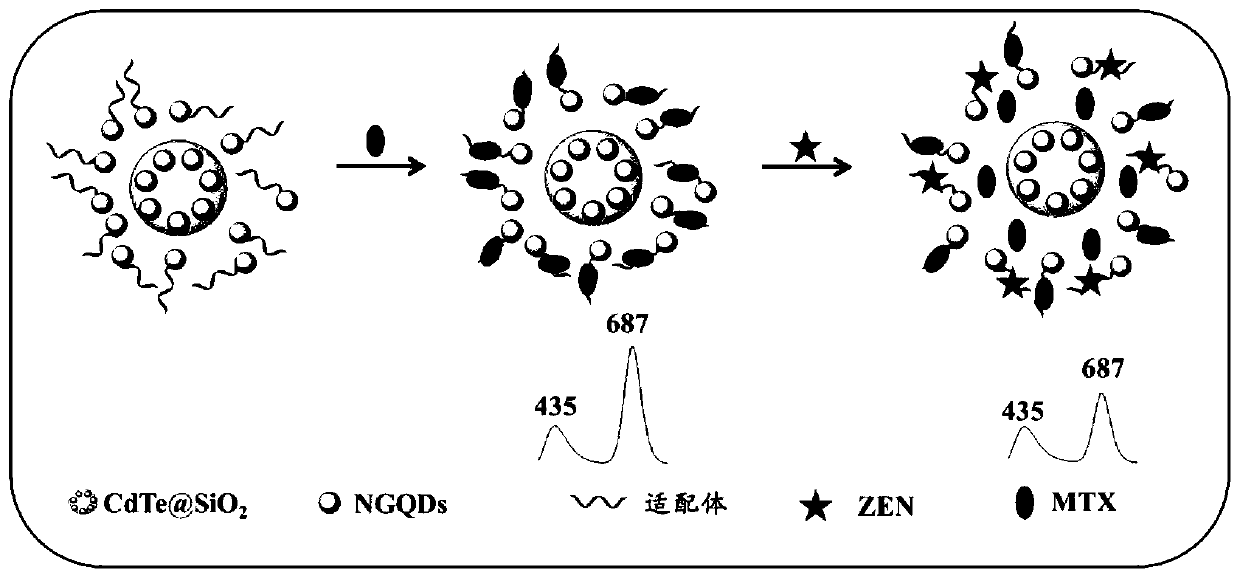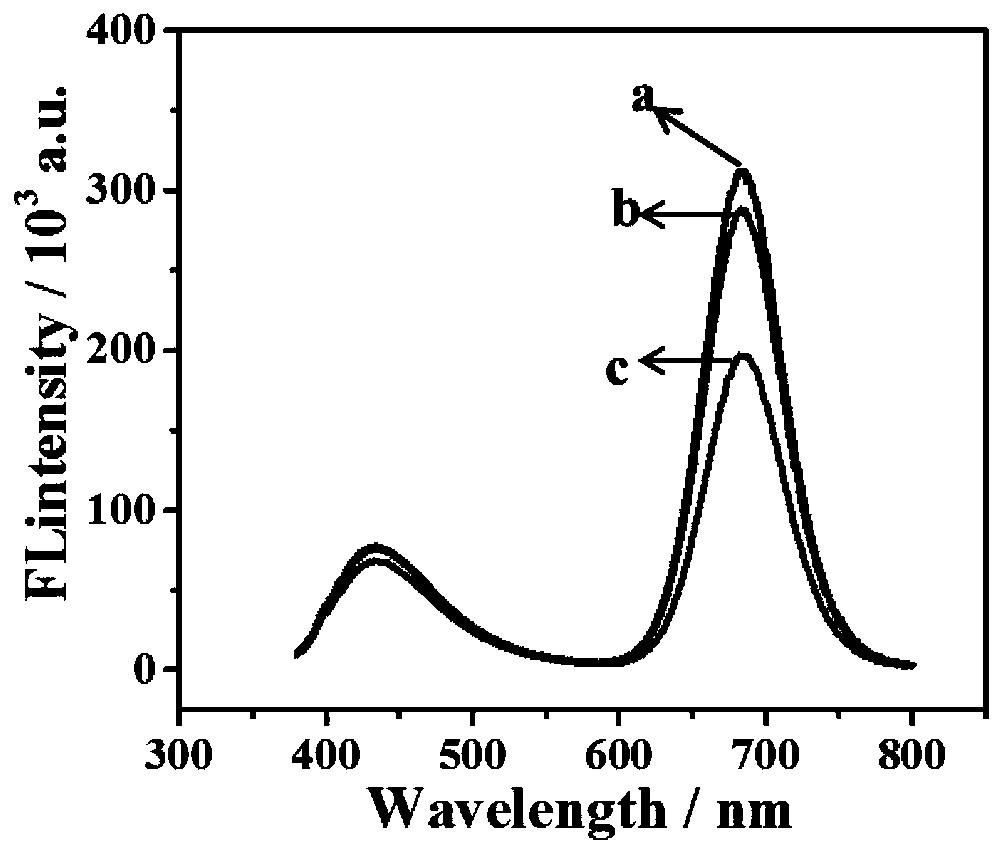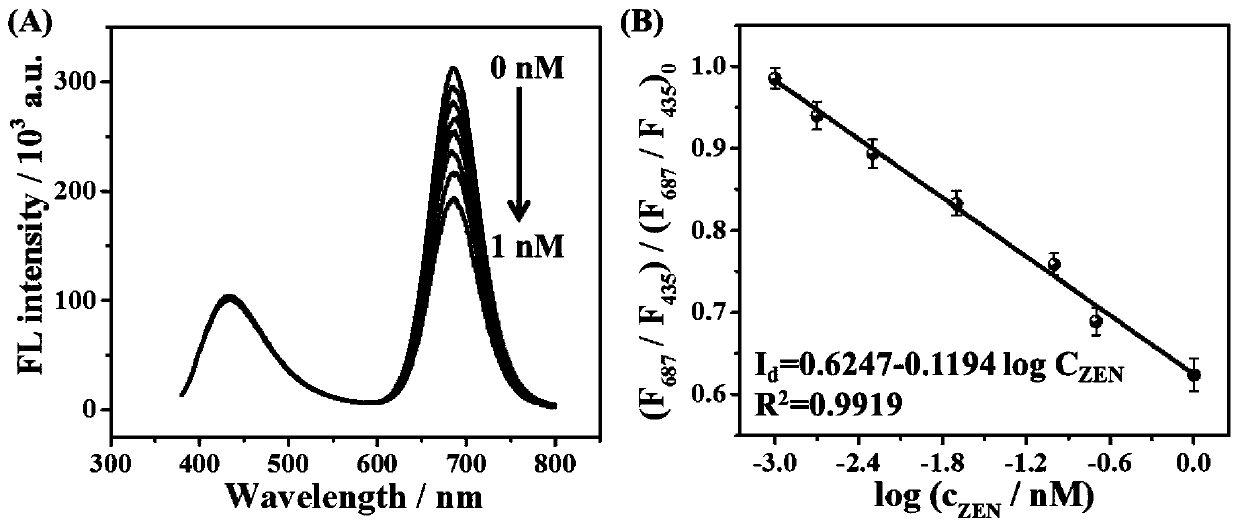Preparation method of ratiometric fluorescent aptamer sensor for detecting zearalenone
An aptamer sensor, zearalenone technology, applied in the direction of fluorescence/phosphorescence, instruments, measuring devices, etc., can solve the problems that have not been reported, and achieve the effect of good selectivity, low cost and high sensitivity
- Summary
- Abstract
- Description
- Claims
- Application Information
AI Technical Summary
Problems solved by technology
Method used
Image
Examples
Embodiment 1
[0037] according to figure 1 In the preparation process, the preparation method of the ratio fluorescent aptamer sensor includes the following steps:
[0038] (1) Synthesis of CdTe QDs;
[0039] Under vigorous stirring, add 0.1142g CdCl 2 ·2.5H 2 Dissolve O in 50mL water, add 75μL mercaptopropionic acid, then use 1mol L -1 Adjust the pH of the solution to 8.5 with NaOH, bubbling with nitrogen for 15 minutes; then, quickly add 2 mL with 0.0646g Te and 0.0457g NaBH 4 Synthesized precursor NaHTe solution; then pour the mixed solution into a three-necked flask after 10 minutes of nitrogen gas, reflux at 100°C for 20 hours to obtain red CdTe QDs with an emission wavelength of 665nm, and add an equal volume of ethanol to centrifuge to remove impurities; After reconstitution, it is dissolved in secondary water and stored at 4°C.
[0040] (2) Synthesis of CdTe@SiO 2
[0041] Mix 1mL 10μM CdTe QDs solution with 6mL ethanol, and stir at room temperature for 5min; then, add 20μLAPTES, and the mi...
Embodiment 2
[0052] Draw ZEN response standard curve and linear regression equation:
[0053] Steps (1) to (5) follow the steps (1) to (5) of Example 1. The difference is that after adding MTX, let it act for 20 minutes, and add 0, 0.001, 0.002, 0.005, 0.02, 0.1, 0.2, 1nM ZEN standard solution, react for 40 minutes. Detect the fluorescence intensity at 435nm and 687nm of the above-mentioned ZEN standard solution of different concentrations with a fluorescence spectrophotometer at room temperature, and the resulting spectrum is as follows image 3 As shown in A, the curve in the figure from top to bottom corresponds to the concentration of ZEN standard solution as 0, 0.001, 0.002, 0.005, 0.02, 0.1, 0.2, 1nM. When 0nM ZEN is added, the fluorescence signal ratio of 687nm and 435nm is recorded as (F 687 / F 435 ) 0 , When other concentrations of ZEN are added, the fluorescence signal ratio of 687nm to 435nm is recorded as (F 687 / F 435 ), get (F 687 / F 435 ) / (F 687 / F 435 ) 0 (With I d Representat...
Embodiment 3
[0055] Investigation of ZEN detection selectivity:
[0056] Prepare the proportional fluorescence aptamer sensor according to the steps in Example 1. Add 30 μL 3nM aflatoxin B1 (AFB1), 3nM fumonisin B1 (FB1), 3nM ochre into 270μL of the ratio fluorescence aptamer sensor for detecting ZEN. Aspergillus toxin (OTA), 0.2nM ZEN and 3nM AFB1, FB1, OTA mixture, after 40 minutes of action, use a fluorescence spectrophotometer at room temperature to detect the fluorescence intensity of the different solutions at 435nm and 687nm. Such as Figure 4 As shown, AFB1, FB1, and OTA have no significant effect on the fluorescence intensity of the dual-signal fluorescent probe, and when ZEN is introduced into the system, the fluorescence signal will be significantly quenched. The above results indicate that the ratio fluorescent aptamer sensing system can realize the specific detection of ZEN.
PUM
 Login to View More
Login to View More Abstract
Description
Claims
Application Information
 Login to View More
Login to View More - R&D
- Intellectual Property
- Life Sciences
- Materials
- Tech Scout
- Unparalleled Data Quality
- Higher Quality Content
- 60% Fewer Hallucinations
Browse by: Latest US Patents, China's latest patents, Technical Efficacy Thesaurus, Application Domain, Technology Topic, Popular Technical Reports.
© 2025 PatSnap. All rights reserved.Legal|Privacy policy|Modern Slavery Act Transparency Statement|Sitemap|About US| Contact US: help@patsnap.com



